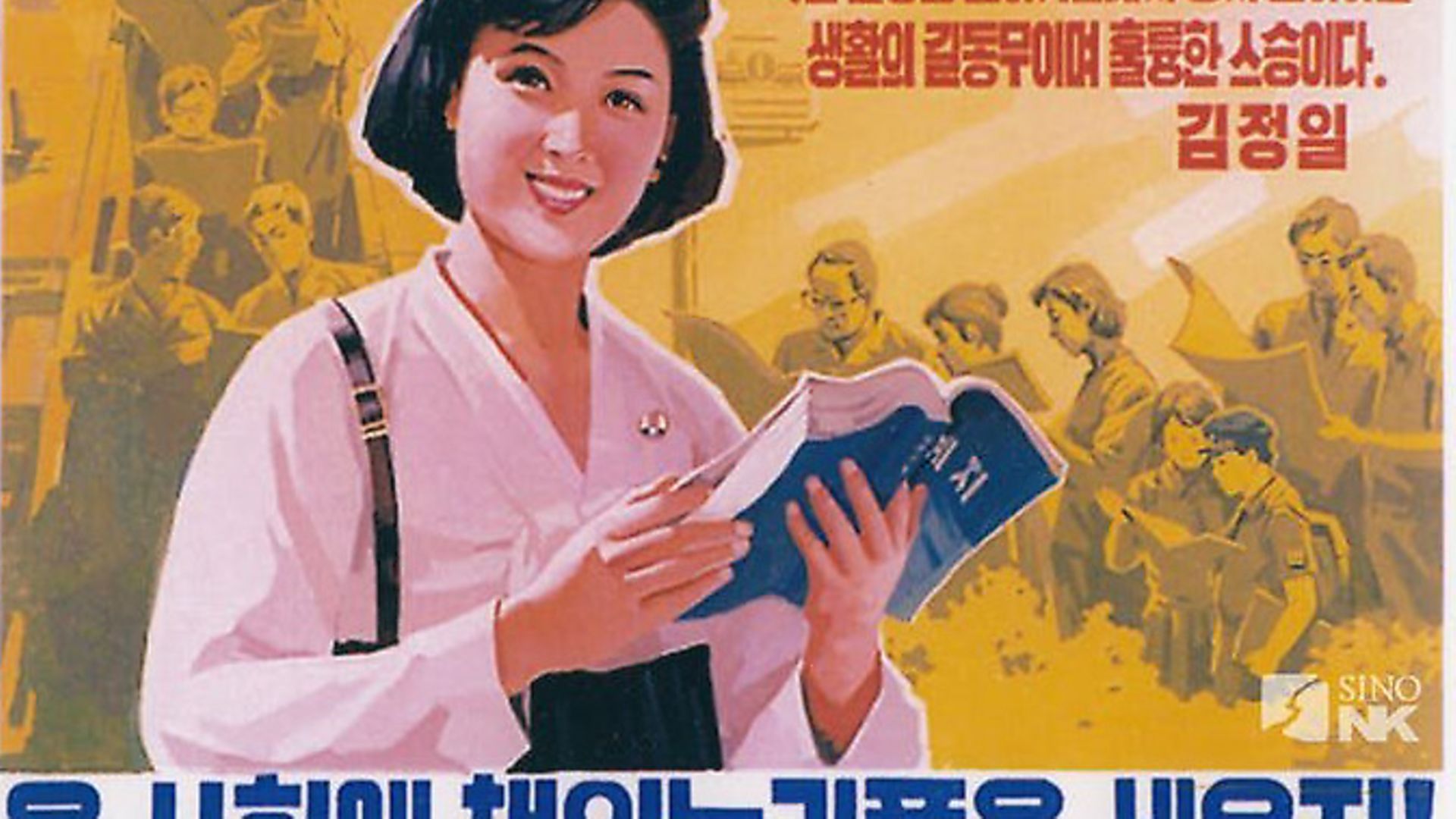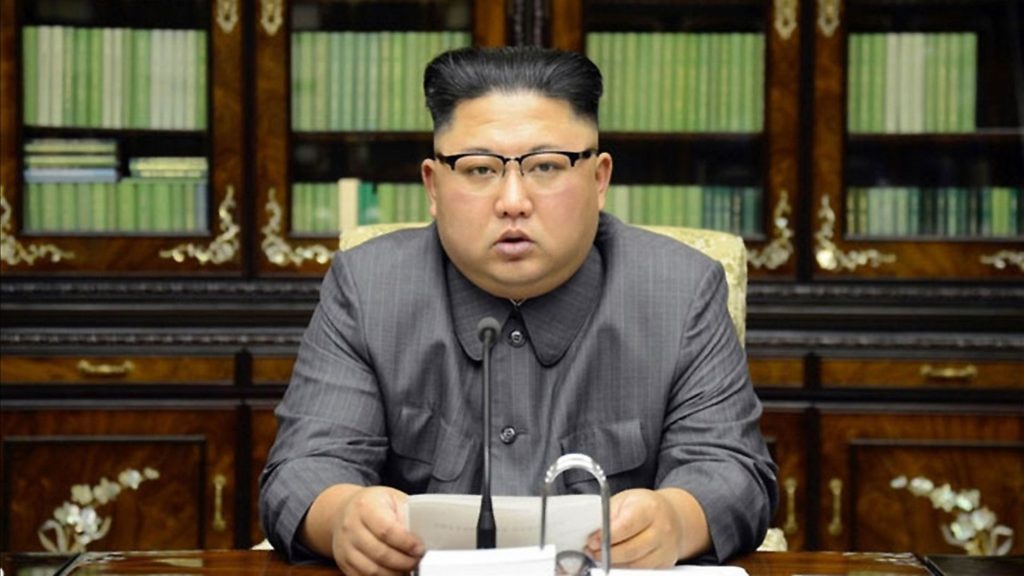
MEREDITH SHAW delves into the literature the secretive state produces for its population and discovers reading between the lines.

With colourful rhetoric about ‘dotards’ (the insult thrown at Donald Trump by Kim Jong-un) and nuclear buttons, North Korean propaganda is certainly attracting attention around the world at the moment.
However, there is another side to the country’s political messaging that is less eye-catching to the rest of the globe: that which is directed at the domestic population.
Difficult to access and written in a highly stylised, dogmatic prose, North Korea’s domestic propaganda is difficult for even South Koreans to understand and is largely ignored abroad. It comprises state-sponsored Chosun Central TV broadcasts, state-produced films, and revolutionary operas and ballads.
But one of the more illuminating forms of internal propaganda is the regime’s state-produced fiction. Published in monthly literary journals, these stories are distributed by the ruling Korean Workers’ Party to select schools and offices around the country.
In an effort to make this internal propaganda more accessible to non-Koreans, I have been translating and blogging about selected works of North Korean fiction as part of my research on the country’s cultural politics.
These stories can offer outsiders revealing insights into the regime’s shifting concerns and priorities, which include a recent campaign to reinforce the legitimacy of their young leader, Kim Jong Un.
No other autocratic regime today has such a well-developed stable of artists and writers producing works aligned with the party’s ideological needs. The Korean Workers’ Party has an extensive bureaucracy in charge of training talent, defining standards and commissioning projects in literature and other branches of the arts.
Like most professionals within North Korea, fiction writers belong to their own organisation within the Party: the Choson Writer’s Union. The Party, therefore, has direct control over what gets written about and which themes get emphasised.
Works of fiction are published in one of a handful of monthly literary journals, the most prestigious of which is Korean Literature, produced by Choson Literature and Art Union Publishing. Other journals include Children’s Literature, Youth Literature and Literary Newspaper.
Within the Choson Writer’s Union, the most elite authors comprise the April 15 Literary Production Unit. This group has produced all the major works dramatising the personal histories of the leaders, including the Immortal History (‘Pulmyol ui Yoksa’) and Immortal Leadership (‘Pulmyol ui Hyangdo’) series, which constructed the official hagiographies of Kim Il-sung and Kim Jong-il, respectively.
The list of authorship of new fiction about Kim Jong-un reveals many well-known names from these series, including Kim Sam Bok, Baek Bo Hum and Chong Ki Jong. Chong, one of North Korea’s most well-known contemporary authors, passed away in 2016, but not before penning the short story Sky, Earth and Sea, which details Kim Jong-un’s role in the Unha and Gwangmyongsong satellite launches.
Since consumer demands and preferences are irrelevant to the creation of North Korean fiction, it cannot be evaluated as a reflection of the average North Korean’s underlying social anxieties (which is how a cultural anthropologist might study literature). Through interviews with North Korean defectors living in Seoul, I found that most North Koreans don’t spend their leisure time reading these journals for fun. Many, however, told me that they had been exposed to these stories at some point in school.
The anthropologists’ loss, however, is the political scientists’ gain. North Korean fiction offers a window into the ruling party’s priorities that is just as informative as its official, externally directed propaganda.
Many of these stories dramatise events in the leaders’ lives. Some are morality tales that showcase characters who embody certain socialist ideals. Others reflect concerns about the geopolitical landscape – and, not surprisingly, American leaders sometimes make guest appearances.
Chong Ki Jong’s most famous novel, Ryoksa ui Taeha, depicts Bill Clinton cowering under blankets during the 1994 crisis, when the US and North Korea came close to war over the latter’s nuclear ambitions. Another short story from around that time, Maehok, tells the story of Jimmy Carter’s visit to North Korea in 1994 from the perspective of his wife Rosalynn, as she meets (and is smitten with) the Great Leader Kim Il-sung.
More recently, however, stories have centred on one subject: Kim Jong-un.
Kim was formally designated as successor in September 2010. Prior to that, his very existence had been virtually unknown to the general public within the country. In a country where schoolchildren ritualistically memorise idealised accounts of their leader and his ancestors, it must have been mind-boggling to see a new leader on television that they knew almost nothing about.
The regime had to rush to put together a personal legend worthy of the grandson of the nation’s founder. The first works of fiction to mention Kim by name appeared in early 2013, over a year after he succeeded his late father as leader. In these stories, there is a marked thematic shift, with an emphasis on youth, creativity and innovation.
For example, the 2017 short story Blossoming Dreams, by Kim Il Su, depicts the young leader as a talent scout of sorts. He finds gifted young artists and architects and encourages them to participate more fully in various national construction projects. At one point he pontificates to one of his advisers about the value of youthful thinking: ‘Our future as a socialist nation of culture will not be built by architects and experts alone. It will require all our citizens to become gardeners and creators adorning our country with beauty. And it is the young generation that must stand up to bring about this bright future. Lately, I hear the saying ‘everything’s getting younger’, but isn’t that wonderful? This era is young, and our people are getting younger… ‘
References to new luxuries and recreational facilities are another notable feature of recent stories. Since Kim became supreme leader, he has poured resources into developing Western-style amusements such as water parks and ski resorts.
One such site, the Rungna People’s Pleasure Ground, attracted international media attention after Kim Jong-un toured the facility in 2012 on his first official photo op with his new wife. An ode to the Rungna park appeared in Literary Newspaper in October 2012, celebrating it as ‘the creation of heaven and earth following the leader’s path’. In Blossoming Dreams, Kim Jong-un’s faithful minister of architecture recalls how the young leader ‘suffered in the summer heat and fierce winds’ when touring the site of the soon-to-be-opened theme park.
A similar prestige project is the new Changjon Street complex in Pyongyang, which features gleaming, high-rise apartment buildings and sports facilities.
In Teacher, a short story published in 2013, a family of schoolteachers is thrilled to receive notice that they have been given a spacious new apartment in the Changjon complex. The family is surprised to learn they made the list: it is well known that the first apartments were supposed to go to ‘workers and innovators’. Later it becomes clear that Kim Jong-un personally directed that some apartments be set aside for educators as well, as part of a general priority for ‘cultivating the next generation’.
North Korean fiction, of course, shouldn’t be interpreted as a realistic depiction of actual conditions within the country. But by reading between the lines, one may discern clues to the regime’s internal concerns, along with the messages it is most eager to convey to its captive domestic audience.
Meredith Shaw is a PhD candidate in politics and international Relations, University of Southern California, Dornsife College of Letters, Arts and Sciences; this article also appears at www.theconversation.com









